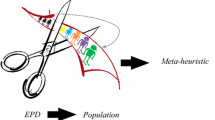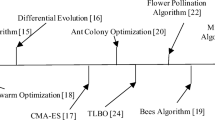Abstract
Elephant search algorithm (ESA) is one of the contemporary meta-heuristic search algorithms recently proposed. The male elephants are responsible for global exploration, roaming to new dimensions of search space. The female elephants focus on doing local search, for finding the optimal solution. A lifespan mechanism is designed to control the birth and death that all agents will have an increasing dead probability with their aging incrementally. This mechanism is set to avoid whole agents falling into local optimum and those new-born elephants will evolve by inheriting heuristic information from the ancestors. In the naïve version of ESA, the search agents expire at equal probability regardless of their current locations. It is supposed that search agents who have shown to improve their solutions are more likely to continue producing better results than those mediocre agents. By this concept, a vitality-based elephant search algorithm called VESA is proposed to fine-tune the lifespan of search agents using a vitality computation mechanism that rewards the good performing agents’ longer life at the expense of the mediocre agents. With the lifespan extended, the fit agents have more time to continue enhancing the solutions. Computer simulation on nine testing functions shows the VESA outperforms the naïve ESA in terms of the final fitness value. A min–max based self-adaptive ratio search strategy is also proposed to help find a good gender ratio in a reasonable time.













Similar content being viewed by others

References
Beheshti Z, Shamsuddin SMH (2013) A review of population-based meta-heuristic algorithms. Int J Adv Soft Comput Appl 5(1):1–35
Bouajaja SE, Dridi N (2017) A survey on human resource allocation problem and its applications. Oper Res Int J 17(2):339–369
Deb K et al (2002) A fast and elitist multiobjective genetic algorithm: NSGA-II. IEEE Trans Evol Comput 6(2):182–197
Deb S, Fong S, Tian Z, Wong RK, Mohammed S, Fiaidhi J (2016) Finding approximate solutions of NP-hard optimization and TSP problems using elephant search algorithm. J Supercomput 24:1–33
Derrac J, García S, Molina D, Herrera F (2011) A practical tutorial on the use of nonparametric statistical tests as a methodology for comparing evolutionary and swarm intelligence algorithms. Swarm Evol Comput. 1(1):3–18
Eleni IV (2007) Prediction of non-recurrent short-term traffic patterns using genetically optimized probabilistic neural networks. Oper Res Int J 7(2):171–184
Fong S, Deb S, Yang X-S (2015) A heuristic optimization method inspired by Wolf preying behavior. Neural Comput Appl 26(7):1725–1738
Kennedy J (2011) Particle swarm optimization. Encyclopedia of machine learning. Springer, New York, pp 760–766
Leung FHF et al (2003) Tuning of the structure and parameters of a neural network using an improved genetic algorithm. IEEE Trans Neural Netw 14(1):79–88
Li MD, Zhao H, Weng XW et al (2016) A novel nature-inspired algorithm for optimization: virus colony search. Adv Eng Softw 92:65–88
Liu H-L, Wang Y, Cheung Y-M (2009) A multi-objective evolutionary algorithm using min-max strategy and sphere coordinate transformation. Intell Autom Soft Comput 15:361–384
Nayak J, Naik B, Behera HS (2016) A novel nature inspired firefly algorithm with higher order neural network: performance analysis. Int J Eng Sci Technol 19(1):197–211
Seymour PD, Thomas R (1993) Graph searching and a min-max theorem for tree-width. J Comb Theory Ser B 58:22–33
Simon F, Robert PB-A, Richard CM (2018) Swarm Search Methods in Weka for Data Mining. In: ICMLC 2018 Proceedings of the 2018 10th international conference on machine learning and computing, ACM, February 26–28, 2018, pp 122–127
Suash D, Simon F, Zhonghuan T (2015) Elephant Search Algorithm for optimization problems. In: 10th International conference on digital information management (ICDIM), 2015 IEEE
Tian Z et al (2016) Optimizing self-adaptive gender ratio of elephant search algorithm by min-max strategy. In: 12th International conference on natural computation, fuzzy systems and knowledge discovery (ICNC-FSKD), IEEE
Vidya TNC, Sukumar R (2005) Social and reproductive behaviour in elephants. Curr Sci 89(7):1200–1207
Yang X-S (2010a) A new meta-heuristic bat-inspired algorithm: Nature inspired cooperative strategies for optimization (NICSO 2010). Springer, Berlin, pp 65–74
Yang X-S (2010b) Firefly algorithm, stochastic test functions and design optimisation. Int J Bio-Inspired Comput 2(2):78–84
Acknowledgment
The authors are thankful for the financial supports from the Research Grants titled: “Temporal Data Stream Mining by Using Incrementally Optimized Very Fast Decision Forest (iOVFDF)”, Grant No. MYRG2015-00128-FST; “Nature-Inspired Computing and Metaheuristics Algorithms for Optimizing Data Mining Performance”, Grant No. MYRG2016-00069-FST; and “A Scalable Data Stream Mining Methodology: Stream-based Holistic Analytics and Reasoning in Parallel”, Grant no. FDCT/126/2014/A3, offered by the University of Macau, and FDCT or Macau SAR government respectively.
Author information
Authors and Affiliations
Corresponding author
Rights and permissions
About this article
Cite this article
Tian, Z., Fong, S., Deb, S. et al. Vitality-based elephant search algorithm. Oper Res Int J 18, 841–863 (2018). https://doi.org/10.1007/s12351-018-0419-9
Received:
Revised:
Accepted:
Published:
Issue Date:
DOI: https://doi.org/10.1007/s12351-018-0419-9



